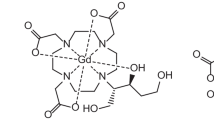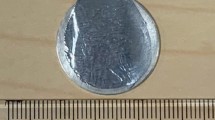Abstract
The most challenging task for establishing a 103Ru/103mRh generator for Auger therapy, is to reach an effective separation between the two radionuclides because of the highly unpredictable, very complicated and poorly understood chemistry. In HCl, this work was able to evidence the formation of Ru colloids. It has been evidenced that the starting material of Ru, time and temperature have a strong influence on Ru speciation, but no polynuclear species of ruthenium–chloride was observed. This work has showed that it is fully possible to control the speciation of ruthenium, especially Ru(IV), within a mononuclear species; that is a huge step forward compared to literature.







Similar content being viewed by others
Data availability statement
Data available on request due to restrictions e.g. privacy or ethical. The data presented in this study are available on request from the corresponding author. The data are not publicly available due to their extended size, incompatible with online upload.
References
Szucs Z, van Rooyen J, Zeevaart JR (2009) Recoil effect on β-decaying in vivo generators, interpreted for 103Pd/103mRh. Appl Radiat Isot 67:1401–1404. https://doi.org/10.1016/j.apradiso.2009.02.022
Epperson CE, Landolt RR, Kessler WV (1976) Solvent-solvent extraction of rhodium-103m from ruthenium-103 employing a sulfate-carbon tetrachloride medium. Anal Chem 48:979–981. https://doi.org/10.1021/ac60371a031
Lawrence MAW, Bullock JL, Holder AA (2017) Basic coordination chemistry of ruthenium. In: Browne WR, Holder AA, Lawrence MA, et al (eds) Ruthenium complexes. Wiley, Germany
Epperson CE (1975) Generator separation of Ru-103/Rh-103m. University of Perdue, Ph.D. Thesis
Niedrach LW, Tevebaugh AD (1951) The polarography of ruthenium (IV) in perchloric acid solutions. J Am Chem Soc 73:2835–2837. https://doi.org/10.1021/ja01150a119
Rard JA (1987) Thermodynamic data bases for multivalent elements : an exemple for Ruthenium. Livermore, California
Yan Y, Wang Q, Xiang Z, Yang Y (2018) Separation of Pt(IV), Pd(II), Ru(III), and Rh(III) from chloride medium using liquid–liquid extraction with mixed imidazolium-based ionic liquids. Sep Sci Technol 53:2064–2073. https://doi.org/10.1080/01496395.2018.1440304
Shock EL, Sassani DC, Willis M, Sverjensky DA (1997) Inorganic species in geologic fluids: correlations among standard molal thermodynamic properties of aqueous ions and hydroxide complexes. Geochim Cosmochim Acta 61:907–950. https://doi.org/10.1016/S0016-7037(96)00339-0
Gigault J, Mignard E, Hadri HE, Grassl B (2017) Measurement bias on nanoparticle size characterization by asymmetric flow field-flow fractionation using dynamic light-scattering detection. Chromatographia 80:287–294. https://doi.org/10.1007/s10337-017-3250-1
Zimm BH (2004) The scattering of light and the radial distribution function of high polymer solutions. J Chem Phys 16:1093–1099. https://doi.org/10.1063/1.1746738
Lebedeva A, Albuquerque BL, Domingos JB et al (2019) Ruthenium trichloride catalyst in water: Ru colloids versus Ru dimer characterization investigations. Inorg Chem 58:4141–4151. https://doi.org/10.1021/acs.inorgchem.8b03144
Giddings JC (1966) A new separation concept based on a coupling of concentration and flow nonuniformities. Sep Sci 1:123–125. https://doi.org/10.1080/01496396608049439
Giddings JC (1977) Polymer analysis and characterization by field-flow fractionation (one-phase chromatography). J Chromatogr 142:23–38
Starik I, Kositsyn A (1957) The state of small amounts of radioactive elements in solutions. U.S. Atomic Energy Commission. Div Isotopes Dev 4052:332–344
Schurtenberger P, Newman ME (1993). In: Environmental particules
Starik I (1958) Adsorption phenomena and their role in radiochemical investigations. U.S. Atomic Energy Commission. Div Isotopes Dev. 4497:282–293
Sorokin V, Zhurin A, Alekseeva M (1971) Ion exchange study of equilibrium between different forms of ruthenium in acid solutions. JApplChem 44:2584–2585
Boncheff AG, Monteiro MA (2011) The detection of ruthenium chloride clusters by laser desorption ionization-mass spectrometry of RuCl3·3H2O. Can J Chem 89:511–516. https://doi.org/10.1139/V11-005
Pantani F (1962) The behavior of ruthenium trichloride in aqueous solutions. JLess-Common Metal 4:116–123
Wehner P, Hindman JC (1952) The chloro complexes of ruthenium(IV). J Phys Chem 56:10–15. https://doi.org/10.1021/j150493a003
Seddon EA, Seddon KR (1984) The chemistry of ruthenium. Elsevier Science. R. J. H. Clark
Woodhead J, Fletcher J (1962) Chloro complexes of Ruthenium. Part I. Groups formed by the reduction of Ruthenium tetroxide with hydro-chloric acid. United Kingdom Atomic Energy Authority. Research Group. Atomic Energy Research Establishment, Harwell, Berks, England
Broszkiewicz RK (1980) Redox reaction of RuCl63- and RuCl62−: a pusle radiolyse study. RadiaPhysChem 15:133–138
Kazakov AG, Ivanov IA, Orlova MA et al (2020) A new method for separation of 97Ru from irradiated by α-particles molybdenum for nuclear medicine. Russ Chem Bull 69:615–619. https://doi.org/10.1007/s11172-020-2807-6
Povar I, Spinu O (2016) Ruthenium redox equilibria: 3. Pourbaix diagrams for the systems Ru-H2O and Ru-Cl–H2O. J Electrochem Sci Eng 6:145–153
Suzuki T, Ogata T, Tanaka M et al (2018) Speciation of ruthenium(III) chloro complexes in hydrochloric acid solutions and their extraction characteristics with an amide-containing amine compound. Metals 8:558. https://doi.org/10.3390/met8070558
Viljoen K (2003) Ruthenium(III) aqua-chloro complex chemistry : the interconversion of the Hexachlororuthenate(III) and Aquapentachlororuthenate(III) species. University of Stellenbosch, Ph.D. Thesis
Khan MMT, Ramachandraiah G, Shukla RS (1988) Ruthenium(III) chloride in aqueous solution: kinetics of the aquation and anation reactions of the chloro complexes. Inorg Chem 27:3274–3278. https://doi.org/10.1021/ic00292a006
Khan MMT, Ramachandraiah G, Rao AP (1986) Ruthenium(III) chloride in aqueous solution: electrochemical and spectral studies. Inorg Chem 25:665–670. https://doi.org/10.1021/ic00225a015
Cady HH, Connick E (1958) The determination of the formulas of aqueous ruthenium (III) species by means of ion-exchange resin: Ru+3, RuCl+2 and RuC12+. University of California, Bekeley
Larenkov A, Mitrofanov I, Pavlenko E, Rakhimov M (2023) radiolysis-associated decrease in radiochemical purity of 177lu-radiopharmaceuticals and comparison of the effectiveness of selected quenchers against this process. Molecules 28:1884. https://doi.org/10.3390/molecules28041884
Acknowledgements
This work has been supported in part by grants from the French National Agency for Research, called “Investissements d’Avenir” IRON Labex no. ANR-11-LABX-0018-01 and ArronaxPlus Equipex no. ANR-11-EQPX-0004. The authors thank the mass spectrometry platform INRAE BIBS (BIA research unit, Nantes, https://www.bibs.inrae.fr) for the analyses performed.
Funding
Agence Nationale de la Recherche, ANR-11-LABX-0018-01, ANR-11-EQPX-0004.
Author information
Authors and Affiliations
Contributions
Conceptualization, S.H.-M., C.A.; methodology, S.H.-M., C.A.; software, C.A., M.T.; validation, S.H.-M., C.A.; formal analysis, M.M.; investigation, M.M.; resources, C.S.; data curation, S.H.-M., C.A., M.T.; writing—original draft preparation, S.H.-M., C.A., M.M., writing—review and editing, S.H-M.; visualization, S.H.-M.; supervision, S.H.-M., C.A.; project administration, S.H-M.; funding acquisition, S.H.-M.
Corresponding author
Ethics declarations
Conflict of interest
The authors declare no conflict of interest. The funders had no role in the design of the study; in the collection, analyses, or interpretation of data; in the writing of the manuscript, or in the decision to publish the results.
Additional information
Publisher's Note
Springer Nature remains neutral with regard to jurisdictional claims in published maps and institutional affiliations.
Rights and permissions
Springer Nature or its licensor (e.g. a society or other partner) holds exclusive rights to this article under a publishing agreement with the author(s) or other rightsholder(s); author self-archiving of the accepted manuscript version of this article is solely governed by the terms of such publishing agreement and applicable law.
About this article
Cite this article
Théry, M., Alliot, C. & Huclier-Markai, S. Recent progress in ruthenium chemistry for establishing a 103Ru/103mRh generator for Auger therapy. J Radioanal Nucl Chem (2024). https://doi.org/10.1007/s10967-024-09484-9
Received:
Accepted:
Published:
DOI: https://doi.org/10.1007/s10967-024-09484-9




